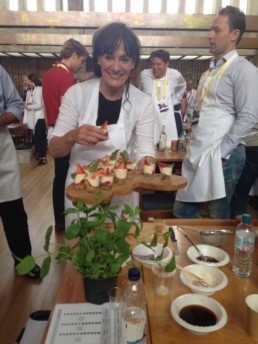In Sickness and in Health
…or the dire state of hospital food
My 89- year old mother recently spent 10 days in hospital, recovering from a minor fall, and, as it turned out, a nasty UTI. The fact that the hospital visit was, apart from an apendectomy aged 13, my mother’s first experience of being admitted to hospital, is quite remarkable at her age.
Having called 999 following her fall, an ambulance crew arrived within 10 minutes and spent the next 30 lugging in what looked like tons of equipment needed to get my mother strapped onto a stretcher, her neck secured and her ECG and blood pressure monitored. It took us less than 10 minutes to arrive at a heaving A&E on Red Alert. Despite being officially over-full, our stay at A&E lasted only a couple of hours, during which time my mother was seen by two doctors and constantly monitored and treated with amazing kindness. An x-ray later, my mother was admitted to a ward where she was to remain for the next 10 days. Fully staffed and constantly attending to their elderly patients, the team did a remarkable job and I could only marvel at what a blessing it is to have an NHS which, certainly in our case, provides wonderful care and service from the moment the superbly equipped ambulance arrived until we left the ward.
Being elderly, and not seriously ill, my mother was made quite aware that the main aim of her hospital stay was to get her back on her feet and feeling stronger. And that’s where the brilliant care hit a wall – for how on earth does anyone weakened by illness, feeling vulnerable and worrying about the immediate future recover if denied access to good food and drink? My mother soon came to dread the ghastly smell of the twice daily hot meals and the sight of brightly coloured plastic menu cards showing items which were as puzzling as they were off-putting. I say items, rather than meals, as about 50% of what was on offer were what I would describe as ingredients, intended to be used in cooking, and the remaining 50% extremely basic nursery food or hitherto unheard-of dishes. Grilled pineapple ring with cheese, anyone?
Tinned tomatoes struck me as particularly sad and depressing. If you have ever tried eating cold, whole tomatoes straight out of the tin – although I can’t see why you would have – you will know that they are extremely acidic, slippery and “tinny”. They are a basic raw ingredient intended for use in sauces and bakes. When presented on its own, as a side dish, they just don’t make any sense at all and this lack of sense infuses all of the food served to patients.
So while junior doctors strike and the media is giving us daily updates on the crisis in the NHS, my mother’s recent experience, including seeing the inner workings of a modern ambulance and a hospital ward, only served to make me appreciate how much this must cost, and what an extraordinary welfare benefit it is to have access to a good health care system. But, the one healing ingredient which does not rely on hugely advanced, cutting edge technology and which ought to be given focus due both to its relatively inexpensive nature and its power to lift spirits and to heal; food, is of the poorest possible standard.
Unless you are seriously ill, days spent in hospital are uneventful and boring. A bit like being on a long-haul flight, boredom rather than hunger makes you look forward to the next meal. Just imagine if those meals were truly delicious and nutritious, offering good quality, healthy comfort food with plenty of vibrant, crisp vegetables and salads. And taking that vision one step further, imagine if patients whose medical condition would allow it, were offered a glass of wine or a “wee dram” to go to sleep on. I am absolutely convinced that this would cut down recovery time and, in the case of elderly patients in particular, would restore a dwindling quest for life, rather than causing ennui and dread. Natural fibre and hydration provided by vegetables and fruit could, I believe, render the dreaded laxative drinks redundant in some of the less severe cases as could a swap to full corn bread in place of the useless white slices of toast served up every morning.
Many a celebrity chef, including Jamie Oliver and Heston Blumethal, have tried to tackle this but failed. Surely it can’t be impossible to demand of the catering companies who supply the NHS that they move into the 21st century. The NHS menus quite simply show a complete lack of understanding of good food and how to apply nutritional considerations. As it battles to cut costs, comparing the hard numbers of food costs against soft ones relating to less time spent in care surely deserves proper consideration.
For the able bodied people in hospital – health care workers and visitors – the food on offer is certainly much more tasty but no more healthy. The food courts have been given over to the large fast food brands serving just the kind of food which we now know cause high cholesterol and weight gain. As a nation we are facing unprecedented issues relating to longevity, obesity and diabetes. Yet tet the very places which are meant to heal us serve patients and medical staff alike sub-standard, unhealthy food fit for no one and least of all those who are frail, down in the dumps and in need of sustenance. The proverbial Jewish chicken soup, the sinecure for all ills, contains a large dose of nutritionally proven healing ingredients as do most “old wives’ tales” relating to the natural health aspects of food. Good food has the power to heal and give us strength and it also lifts the human spirit like few other things on earth. Shouldn’t it be on the NHS menu?
In defence of Food
July 23, 2016
9 days to go…
September 30, 2015
A Food Safari for 150 at Churchill college
July 17, 2015
Joining Simply Good Food TV
June 20, 2015



